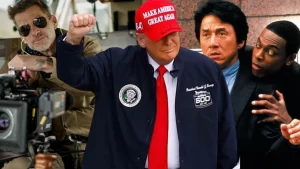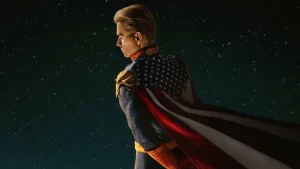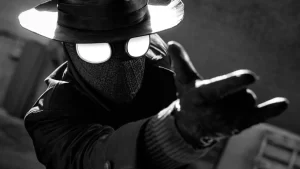Capitalist Pigs, Communist Dogs and a Third Option
A Film Review of Atlas Shrugged: Part 1
By: Lawrence Napoli
“You have heard no concepts of morality but the mystical or the social . . . For centuries, the battle of morality was fought between those who claimed that your life belongs to God and those who claimed that it belongs to your neighbors-between those who preached that the good is self sacrifice for the sake of ghosts in heaven and those who preached that the good is self-sacrifice for the sake of incompetents on earth. And no one came to say that your life belongs to you and that the good is to live it.” – John Galt in Atlas Shrugged
 Picture this: the American economy is in utter disarray. Unemployment and poverty is on the rise while politicians and “leaders” of industry continue to profit. Global economic unrest has caused social instability and forced some countries to take drastic steps in controlling their respective populaces. The American Dream is dead. Does any of this sound familiar? No, this is not a commentary on the state of affairs in the real world of the United States in the year 2011, it is the precise setting of the fictional world of Atlas Shrugged: Part 1 where business dynamo (and heroine) Dagny Taggart is pitted against corrupt politics and short-sighted competition to survive the cutthroat game of capitalism where the deck is heavily stacked against her. By aligning her railroad company with a steel production corporation that has developed a revolutionary alloy, Dangy’s company has been targeted for termination by her competitors for not obeying the same “rules” of corporate profit the rest have agreed upon. Amidst this turmoil, Dagny is struggling to maintain employment with some of her most talented researchers and managers and finds this is a growing trend in every aspect of productive society. A national conspiracy seems to be unfolding with Taggart Transcontinental at the center of it all.
Picture this: the American economy is in utter disarray. Unemployment and poverty is on the rise while politicians and “leaders” of industry continue to profit. Global economic unrest has caused social instability and forced some countries to take drastic steps in controlling their respective populaces. The American Dream is dead. Does any of this sound familiar? No, this is not a commentary on the state of affairs in the real world of the United States in the year 2011, it is the precise setting of the fictional world of Atlas Shrugged: Part 1 where business dynamo (and heroine) Dagny Taggart is pitted against corrupt politics and short-sighted competition to survive the cutthroat game of capitalism where the deck is heavily stacked against her. By aligning her railroad company with a steel production corporation that has developed a revolutionary alloy, Dangy’s company has been targeted for termination by her competitors for not obeying the same “rules” of corporate profit the rest have agreed upon. Amidst this turmoil, Dagny is struggling to maintain employment with some of her most talented researchers and managers and finds this is a growing trend in every aspect of productive society. A national conspiracy seems to be unfolding with Taggart Transcontinental at the center of it all.
Atlas Shrugged: Part 1 is a relatively small budget production that has seen extremely limited releases in small theaters across the country that feature Indy Films. It has been ridiculed for its less than stellar takes at the box office, but there are three very important reasons for this: 1) there was virtually no advertising for it, 2) it is a film that forces the viewer to think and 3) is extremely subversive to the status quo in regards to the socio, economic and political power structure that dictates the course of the United States and perhaps the entire planet. Make no mistake Mr. or Ms. Reader, this is not a film that either the filthy rich or the ridiculously powerful want you to view, comprehend and analyze because it speaks to empowering the individual and such a creature is dangerous because it cannot be controlled. No major studio was affiliated with the production and distribution of this film and there were no major Hollywood stars attached in either the cast or production team. Everything about this film production screams “DANGER, EPIC FAIL!” but then I am reminded of a similar reception by “the public” of the original novel by Ayn Rand in 1957. It too was panned by critics, but over the course of time, developed a cult following among readers.
This film adaptation is by no means a true masterpiece as it is an extremely flawed film that is mired with plot gaps, dense dialogue and a severe misuse of the main source of mystery and suspense: “Who is John Galt?” The director, Paul Johansson is more known for his acting appearances in television shows such as One Tree Hill and Beverly Hills, 90210. Screenplay writer/producer, John Aglialoro, is making his rookie debut in major film production with Atlas Shrugged. Even a super team of Phillip K. Dick and Steven Spielberg would be hard pressed to produce an adaptation as intriguing as the source material. Be that as it may, the lone strength of this film is the shock value derived from an alternate interpretation of how national policy is made and major businesses are run. This film clearly designates CEO’s and boards of directors as the true (and sole) visionaries of the country. Government and media institutions are used as mindless tools to facilitate corporate ends through the manipulation of fear. In addition, the macro-economic model that is used by corporations that are supposedly competitors is actually an example of privileged socialism where they work in tandem to consolidate their collective influence and against those who would disrupt the flow of wealth and power in their favor.
Indeed, this is a film that caters to the conspiracy theorist and in order to follow the plot, one must be willing to wade through a murky swamp of “corporate-ese” that is layered throughout most of the dialogue. As a result, the film tends to get a bit preachy at times. Using the limited screen time for more character development and plot twists would have served this film better. In addition, the lack of action is a severe crutch for this narrative because nothing demonstrates desperation better than a gun in the face. One would think that in a country like America at least one corporate executive would have been accosted by a company’s formerly employed peon, but not so in Atlas Shrugged. The main reason why word of mouth has not inspired more ticket sales is because this type of political drama will not appeal to everyone. Had this film chosen to use the increasing “disappearances” of America’s innovators as the engine for the plot, the mystery would have been at the forefront and with it, the potential for more action. Instead, the most interesting aspect of this story is treated as an afterthought that only becomes important to the film’s protagonist in the closing scene.
The production value of this estimated $15 million dollar budget was very high considering the fact that no major sponsors were attached. Of course, it stands to reason that no established corporation would support such a franchise, but I found it very interesting how even the Ayn Rand estate neither endorses nor denounces this film in the end credits [note: this is specifically stated as such]. The interior locations for various restaurants, mansions and business offices were appropriately lavish and sophisticated for the corporate characters as their primary venue for interaction. This contrasts quite well with the deteriorating urban environment and the expansive plains of the Midwest which are two areas the audience also sees our corporate heroes participate in. Perhaps these three settings were selectively chosen for their political counterparts in the story: posh interiors = capitalism, decayed urban = communism and untouched rural = the unknown third option. Effects were very minimal for this film as the Galt Line train sequence and disaster in the film’s final moments represent the lion’s share of the spectacle. I presume the smallest share of the expenses went to the cast as it is riddled with character actors you’ve all seen before, but will struggle to remember their names.
As for the performances, I can say they were adequately functional as a whole with no one individual standing out with any semblance of intensity. And perhaps that is the point because the film makes no secret of the fact that most people view CEO types as nameless, faceless and emotionless and to a certain extent, they carry themselves in that manner on purpose. But these are not super humans, merely super privileged and are capable of producing emotion outside of profit driven greed. Taylor Schilling is a relative unknown, but was well chosen as the main character Dagny Taggart for the hard lines of her attractive facial features. Her look compliments her performance as stern, but not nearly dominating enough for my tastes as the woman who clearly runs the show for her company in a corporate world that has always been dominated by men. Schilling attempts to evoke sympathy in her more emotive scenes but comes off as soft more often than not as she has a tendency of lower her character’s status in scenes with men that are potential and former lovers. Grant Bowler matches Schilling’s bland but sophisticated demeanor as her love interest and business partner, Henry Reardon. I found Bowler’s performance to be a tad more sympathetic because the audience is given more scenes that outline the façade of his personal relationships and clearly defines him as a lone wolf.
Remember those character actors I referred to? You’ll remember Graham Beckel as Dick Stensland from L.A. Confidential and he produces the most emotive performance of all the corporate entities as Ellis Wyatt. You’ll remember Matthew Marsden as the Umbrella Agent who gets a face full of tentacles in the end of Resident Evil: Extinction and he really stirs up the bile as the prototypical smug and clueless CEO, James Taggart. You’ll remember Jon Polito from great films like Miller’s Crossing (the high hat?) and The Big Lebowski (brother shamus) in a severely underused role as corporate antagonist Orren Boyle. You’ll remember Michael Lerner as the character everyone wants to see dead in films like Eight Men Out, Newsies, and No Escape as he produces yet another annoyingly caustic performance as the lobbyist Wesley Mouch. There are certainly a few more recognizable faces, but the gist is there are quite a few of them and they all do their brief jobs well. I really would have enjoyed some alpha talent attached to the female lead, but upon further review of current A-List talent, only Meryl Streep minus 30 years could have pulled the role off flawlessly.
I was eager to witness this visual rendition of the original story that directly inspired the morbidly steam-punk fiction of BioShock. I was left unimpressed. Had more focus been given to the mystery and conspiracy of the story, a more visually dynamic and interesting film would have followed. Atlas Shrugged: Part 1 is very much like Fight Club in that both films have a clear agenda of promoting a particular philosophy based in the anti-establishment. Although everyone knows the rules to Fight Club, that film was only a modest financial success, earning $10 million over budget at the box office – and it had Brad Pitt shirtless and ‘roided out! The only calling card for Atlas Shrugged is John Galt, but nobody knows who he is; Keyser Söze perhaps?







